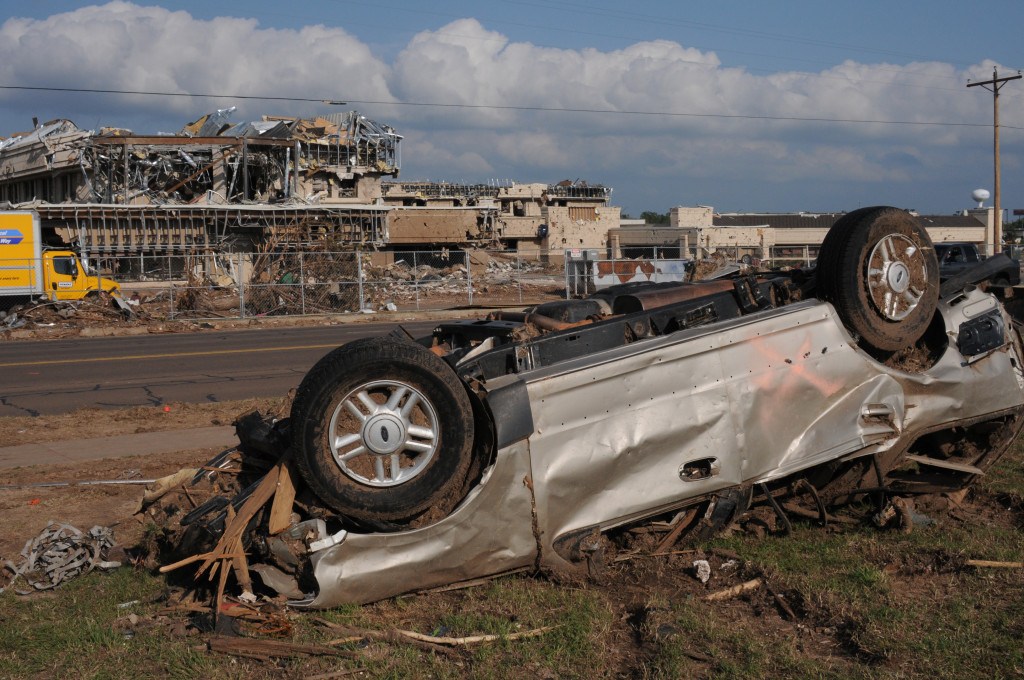Oklahoma hasn’t had a tornado or a tornado warning for more than eight months, though with bad storms expected in the state Sunday, it is doubtful Oklahoma will be able to match its longest streak ever without a twister.
Things have been unusually quiet through the first three months of 2014 – mainly due to a drought that began late last summer and intensified through the winter. Oklahoma typically has five tornadoes from January through March. This year, there have been none.

After a fury of powerful twisters raked the Oklahoma City suburbs of Moore and El Reno during a two-week period last May, killing dozens of people and injuring hundreds more, the last tornado touchdown in the state was reported Aug. 7, a brief funnel near the Panhandle town of Turpin.
The current streak of 248 days without a tornado or tornado warning ties the state’s second-longest period. The longest streak without a tornado in the state lasted 292 days and stretched from May 17, 2003, to March 3, 2004, according to the National Weather Service in Norman.
Why so quiet in the gut of Tornado Alley, at least since August? The necessary conditions – systems approaching from the west, lingering over a region while sucking up plenty of moisture from the Gulf of Mexico; the dry line that forms, then the cold front and the potential nastiness – just haven’t been present at the right times, said Gary McManus, Oklahoma’s state climatologist.
“It ties to the drought,” McManus said. “We haven’t had a lot of chances to get those proper ingredients to get tornadoes.
“It’s a condition of timing and a condition of opportunity,” he said.
While forecasting offices report lower than normal tornado activity during the past few years in the U.S., some states, including Oklahoma, provide the cautionary tales for any notion that 2014 could turn out to be a dud.
“The problem is that it only takes one (tornado),” said Greg Carbin, the warning coordination meteorologist for the National Oceanic and Atmospheric Administration ‘s Storm Prediction Center in Norman. “Every day that goes by when we remain in this relatively tranquil pattern suggests we will remain below normal, but all it takes is one place at the wrong time and we have a real problem on our hands.
“At the beginning of May last year, it was about as quiet as you’ll see, and then right in the middle of the month, danger turned the switch on,” he said.
Twenty-four people were killed and more than 1,000 homes destroyed in the EF5 tornado at Moore on May 20. That storm had winds exceeding 200 mph.
Less than two weeks later, the widest-recorded tornado at 2.6 miles struck south of El Reno – part of a violent storm system that also produced flooding and high winds. That storm was rated EF3 for its damage, but its winds were recorded at nearly 300 mph.
Adam Houston, associate professor of atmospheric science at the University of Nebraska-Lincoln, cautioned that some statistics or studies suggesting a lull in overall tornado activity can be misleading and potentially dangerous to the public.
“Just because we have a reduced number of tornadoes nationwide doesn’t mean we can’t get an EF5, and an EF5 that hits a major metropolitan area. We can still get these epic, individual events that kill a lot of people and do a lot of damage,” Houston said.
“If it’s mid-June and were having this conversation, that’s another thing,” he said.
Predictions on what kind of tornado season it could be are quickly shrugged off by storm chasers like Charles Edwards. He operates Cloud 9 Tours, a Norman-based business that’s packed vans full of adrenaline-junkie tourists in vans since 1996 to drive them across America’s countryside, chasing twisters- all for $2,900 a head.
“Oh, it doesn’t really worry me,” said Edwards, who has lost track of the hundreds of tornadoes he’s witnessed in his career and is already booking seats on his 2015 jaunts. “You never can tell. You can have a dry period for months, then things turn around.”
Was this article valuable?
Here are more articles you may enjoy.


 AccuWeather’s US Winter Forecast Calls for a Temperature Roller Coaster
AccuWeather’s US Winter Forecast Calls for a Temperature Roller Coaster  Advocacy Groups Ask FIO to Release Homeowners Insurance Data Collected by NAIC
Advocacy Groups Ask FIO to Release Homeowners Insurance Data Collected by NAIC  Jane Street-Millennium Trade Secrets Fight Ends in Settlement
Jane Street-Millennium Trade Secrets Fight Ends in Settlement  Amazon Ignored Its Own Worker Safety Studies, Senate Report Says
Amazon Ignored Its Own Worker Safety Studies, Senate Report Says 